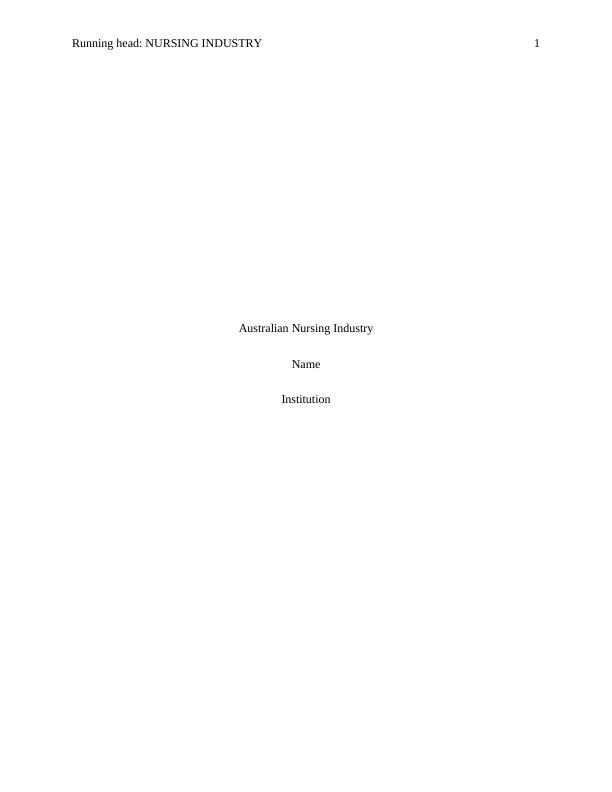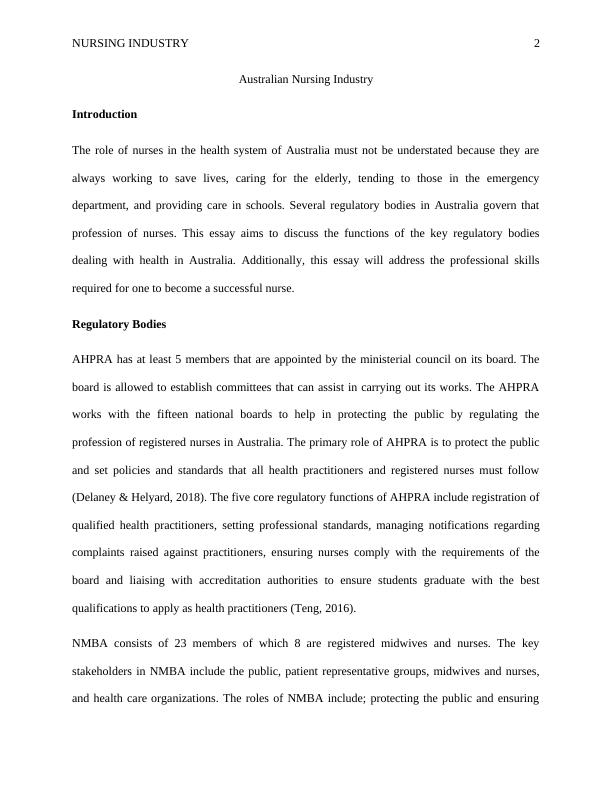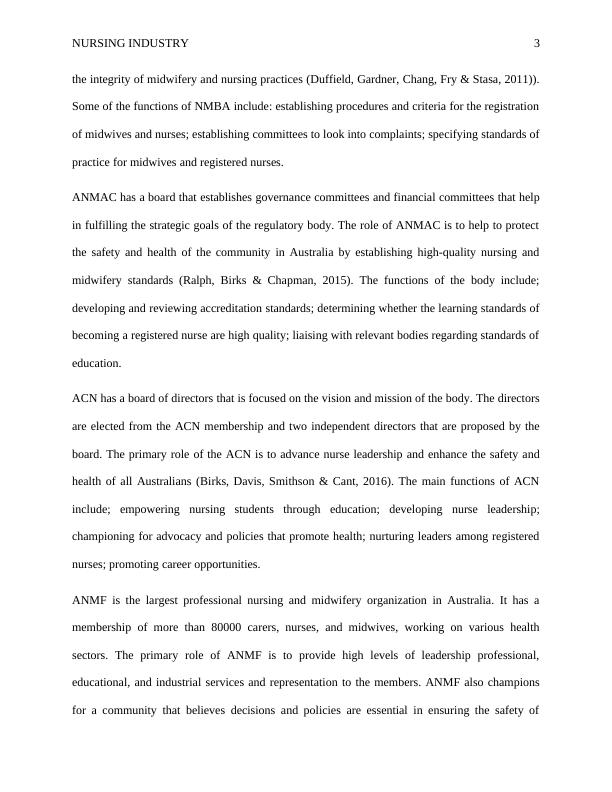Australian Nursing Industry
Added on 2022-08-18
7 Pages1825 Words15 Views
Running head: NURSING INDUSTRY 1
Australian Nursing Industry
Name
Institution
Australian Nursing Industry
Name
Institution

NURSING INDUSTRY 2
Australian Nursing Industry
Introduction
The role of nurses in the health system of Australia must not be understated because they are
always working to save lives, caring for the elderly, tending to those in the emergency
department, and providing care in schools. Several regulatory bodies in Australia govern that
profession of nurses. This essay aims to discuss the functions of the key regulatory bodies
dealing with health in Australia. Additionally, this essay will address the professional skills
required for one to become a successful nurse.
Regulatory Bodies
AHPRA has at least 5 members that are appointed by the ministerial council on its board. The
board is allowed to establish committees that can assist in carrying out its works. The AHPRA
works with the fifteen national boards to help in protecting the public by regulating the
profession of registered nurses in Australia. The primary role of AHPRA is to protect the public
and set policies and standards that all health practitioners and registered nurses must follow
(Delaney & Helyard, 2018). The five core regulatory functions of AHPRA include registration of
qualified health practitioners, setting professional standards, managing notifications regarding
complaints raised against practitioners, ensuring nurses comply with the requirements of the
board and liaising with accreditation authorities to ensure students graduate with the best
qualifications to apply as health practitioners (Teng, 2016).
NMBA consists of 23 members of which 8 are registered midwives and nurses. The key
stakeholders in NMBA include the public, patient representative groups, midwives and nurses,
and health care organizations. The roles of NMBA include; protecting the public and ensuring
Australian Nursing Industry
Introduction
The role of nurses in the health system of Australia must not be understated because they are
always working to save lives, caring for the elderly, tending to those in the emergency
department, and providing care in schools. Several regulatory bodies in Australia govern that
profession of nurses. This essay aims to discuss the functions of the key regulatory bodies
dealing with health in Australia. Additionally, this essay will address the professional skills
required for one to become a successful nurse.
Regulatory Bodies
AHPRA has at least 5 members that are appointed by the ministerial council on its board. The
board is allowed to establish committees that can assist in carrying out its works. The AHPRA
works with the fifteen national boards to help in protecting the public by regulating the
profession of registered nurses in Australia. The primary role of AHPRA is to protect the public
and set policies and standards that all health practitioners and registered nurses must follow
(Delaney & Helyard, 2018). The five core regulatory functions of AHPRA include registration of
qualified health practitioners, setting professional standards, managing notifications regarding
complaints raised against practitioners, ensuring nurses comply with the requirements of the
board and liaising with accreditation authorities to ensure students graduate with the best
qualifications to apply as health practitioners (Teng, 2016).
NMBA consists of 23 members of which 8 are registered midwives and nurses. The key
stakeholders in NMBA include the public, patient representative groups, midwives and nurses,
and health care organizations. The roles of NMBA include; protecting the public and ensuring

NURSING INDUSTRY 3
the integrity of midwifery and nursing practices (Duffield, Gardner, Chang, Fry & Stasa, 2011)).
Some of the functions of NMBA include: establishing procedures and criteria for the registration
of midwives and nurses; establishing committees to look into complaints; specifying standards of
practice for midwives and registered nurses.
ANMAC has a board that establishes governance committees and financial committees that help
in fulfilling the strategic goals of the regulatory body. The role of ANMAC is to help to protect
the safety and health of the community in Australia by establishing high-quality nursing and
midwifery standards (Ralph, Birks & Chapman, 2015). The functions of the body include;
developing and reviewing accreditation standards; determining whether the learning standards of
becoming a registered nurse are high quality; liaising with relevant bodies regarding standards of
education.
ACN has a board of directors that is focused on the vision and mission of the body. The directors
are elected from the ACN membership and two independent directors that are proposed by the
board. The primary role of the ACN is to advance nurse leadership and enhance the safety and
health of all Australians (Birks, Davis, Smithson & Cant, 2016). The main functions of ACN
include; empowering nursing students through education; developing nurse leadership;
championing for advocacy and policies that promote health; nurturing leaders among registered
nurses; promoting career opportunities.
ANMF is the largest professional nursing and midwifery organization in Australia. It has a
membership of more than 80000 carers, nurses, and midwives, working on various health
sectors. The primary role of ANMF is to provide high levels of leadership professional,
educational, and industrial services and representation to the members. ANMF also champions
for a community that believes decisions and policies are essential in ensuring the safety of
the integrity of midwifery and nursing practices (Duffield, Gardner, Chang, Fry & Stasa, 2011)).
Some of the functions of NMBA include: establishing procedures and criteria for the registration
of midwives and nurses; establishing committees to look into complaints; specifying standards of
practice for midwives and registered nurses.
ANMAC has a board that establishes governance committees and financial committees that help
in fulfilling the strategic goals of the regulatory body. The role of ANMAC is to help to protect
the safety and health of the community in Australia by establishing high-quality nursing and
midwifery standards (Ralph, Birks & Chapman, 2015). The functions of the body include;
developing and reviewing accreditation standards; determining whether the learning standards of
becoming a registered nurse are high quality; liaising with relevant bodies regarding standards of
education.
ACN has a board of directors that is focused on the vision and mission of the body. The directors
are elected from the ACN membership and two independent directors that are proposed by the
board. The primary role of the ACN is to advance nurse leadership and enhance the safety and
health of all Australians (Birks, Davis, Smithson & Cant, 2016). The main functions of ACN
include; empowering nursing students through education; developing nurse leadership;
championing for advocacy and policies that promote health; nurturing leaders among registered
nurses; promoting career opportunities.
ANMF is the largest professional nursing and midwifery organization in Australia. It has a
membership of more than 80000 carers, nurses, and midwives, working on various health
sectors. The primary role of ANMF is to provide high levels of leadership professional,
educational, and industrial services and representation to the members. ANMF also champions
for a community that believes decisions and policies are essential in ensuring the safety of

End of preview
Want to access all the pages? Upload your documents or become a member.
Related Documents
Nursing and Stress Management l Assignmentlg...
|8
|1974
|18
Australian Nursing Industry Analysis 2022lg...
|11
|1911
|24
The Nursing Industry in Australialg...
|8
|1568
|15
Professional Nursing Planning | Australian Nursing Industrylg...
|6
|1393
|19
Foundation of Professional Planning Case Study 2022lg...
|10
|1642
|19
Legal and Professional Issues in Nursing- Doclg...
|9
|1901
|81
